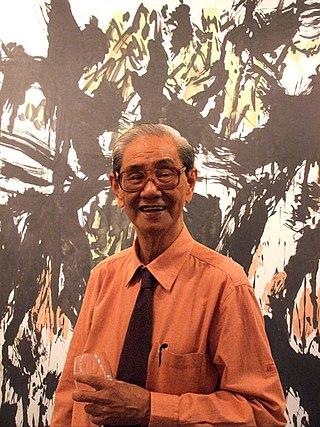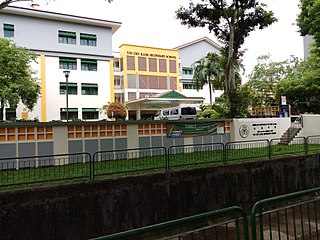
The North–South Line (NSL) is a high-capacity Mass Rapid Transit (MRT) line in Singapore, operated by SMRT Corporation. Coloured red on the Singapore rail map, the line is 45 kilometres (28 mi) long and serves 27 stations, 11 of which, between the Braddell and Marina South Pier stations, are underground. It runs from Jurong East station, located in Western Singapore, to Marina South Pier station in the Central Area, via Woodlands station in northern Singapore. The line operates for almost 20 hours a day, with headways of 1 to 2 minutes during peak hours and 5 to 6 minutes during off-peak hours. All the trains on the North–South Line run with a six-car formation.

Ang Mo Kio is a planning area and residential town situated in the Central region of Singapore. Located approximately 11 km north of the Downtown Core district, Ang Mo Kio is the 3rd most populated planning area in the North-East region and ranks 8th in terms of population in the country overall. The planning area is located at the south-western corner of the North-East region, bordered by the planning areas of Yishun to the north, Sengkang to the north-east, Serangoon to the east, Bishan to the south and the Central Water Catchment to the west.

The Chinese High School was an independent school in Singapore offering secondary education. The school merged with Hwa Chong Junior College on 1 January 2005 to form the integrated Hwa Chong Institution.

Serangoon is a planning area and residential town located in the North-East Region of Singapore.

The Seletar Expressway is a highway in Singapore that traverses the northern end of the island and joins the Central Expressway (CTE) and the Tampines Expressway (TPE) in Seletar to the Bukit Timah Expressway (BKE) in Kranji.

Yio Chu Kang MRT station is an above-ground Mass Rapid Transit (MRT) station on the North South line in Ang Mo Kio, Singapore, near the junction of Ang Mo Kio Avenue 6 and Ang Mo Kio Avenue 8.

Chung Cheng High School (Main) is a co-educational government-aided autonomous Special Assistance Plan (SAP) secondary school in Singapore. Founded in 1939, it is one of the eleven SAP secondary schools in Singapore. Another Secondary School in Singapore, Chung Cheng High School (Yishun), is its sister school.
The romanisation of the Chinese language in Singapore is not dictated by a single policy, nor is its policy implementation consistent, as the local Chinese community is composed of a myriad of topolect groups. Although Hanyu Pinyin is adopted as the preferred romanisation system for Mandarin and the standard of Chinese education, the general lack of a romanisation standard for other Chinese varieties results in some level of inconsistency. This may be illustrated by the many variants for the same Chinese characters often found in surnames such as Low, Loh, Lo; Tay, Teh; Teo, Teoh; Yong, Yeong.

Thomson Road is a major trunk road linking Singapore's central business district with the northern suburban areas of the country. The road is one of the longest in Singapore, starting from Novena in the south towards MacRitchie Reservoir, before continuing northwards as Upper Thomson Road towards Yishun and Sembawang.

CHIJ St. Nicholas Girls' School (SNGS) is a government-aided autonomous Catholic girls' school in Ang Mo Kio, Singapore. The school is one of 11 Convent of the Holy Infant Jesus (CHIJ) schools in Singapore and one of the designated Special Assistance Plan (SAP) schools. It offers a six-year primary education in its primary school section and a four-year secondary education in its secondary school section. Since 2013, it has partnered with Eunoia Junior College for a six-year Integrated Programme, which allows its secondary school students to skip the Singapore-Cambridge GCE Ordinary Level examinations and proceed to Eunoia for Years 5 and 6 and take the Singapore-Cambridge GCE Advanced Level examinations at the end of Year 6.

The North-East Region of Singapore is one of the five regions in the country. The region is the most densely populated and has the highest population among the five, with Sengkang being its most populous town as of 2020 and Seletar as the regional centre. Comprising 13,810 hectares, it includes seven planning areas and is largely a residential region with 217,120 homes. Housing largely consists of high-density HDB public housing estates, however private housing is also present in the region. As its name implies, it is located in the north-eastern part of Singapore.

Lim Tze Peng is a Singaporean artist who is a teacher by training and profession. He was awarded a Cultural Medallion in 2003 in recognition of his contribution to the country's art and culture. In June 2021, it was reported that he was still producing art at the age of 99.
The Branch MRT line, also known as the Bukit MRT line, was originally the third Mass Rapid Transit (MRT) line in Singapore, initially operating as a branch to the existing East–West Line. The line was 6.5 kilometres (4.0 mi) long with four stations, and was operated by SMRT Corporation.

Yio Chu Kang Secondary School is a co-educational government school in Ang Mo Kio, Singapore. It was first opened in 1966, and moved to its current site in 1982.
Seng Han Thong is a Singaporean former politician. A member of the governing People's Action Party (PAP), he was a Member of Parliament representing the Yio Chu Kang ward of Ang Mo Kio GRC from 1997 to 2006, and Yio Chu Kang SMC from 2006 to 2011.
Braddell Secondary School was a co-educational government secondary school in Singapore. It started operations in 1981 and ceased to exist in 2000, when it was merged with Westlake Secondary School to form Braddell-Westlake Secondary School
Sebastian Teo Kway Huang is a Singaporean politician and businessman. He was formerly the president of the National Solidarity Party (NSP).

Yip Hon Weng is a Singaporean politician, former civil servant and teacher. A member of the governing People's Action Party (PAP), he has been the Member of Parliament (MP) representing Yio Chu Kang SMC since 2020.

Quah Chin Lai was a Singapore metal and machinery hardware tycoon and philanthropist.

Naval Base Secondary School (NBSS) is a co-educational government secondary school in Yishun, Singapore. Founded in 1957, NBSS initially began as a school for children of employees of the British Navy. Since 2003, NBSS has been organizing overseas trips for their students to decrease delinquency along with getting students more interested in the arts.
















